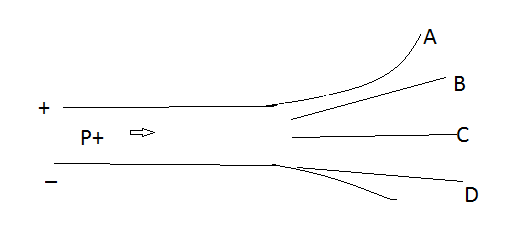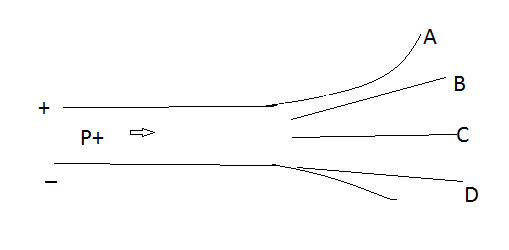Question
Question: A proton moving at constant velocity enters the region between two charged plates, as shown below. W...
A proton moving at constant velocity enters the region between two charged plates, as shown below. Which of the paths shown correctly indicates the proton's trajectory after leaving the region between the charged plates?

A)A
B)B
C)C
D)D
Solution
Protons are found in the nucleus of the atom. Proton is a stable subatomic particle. Protons are the tiny and dense region at the center of the atom. It is a positively charged particle. Protons are considered elementary particles in particle physics.
Complete step by step solution:

In a given figure, a proton is kept between the two plates. One side of the plate is positively charged and the other side of the plate is negatively charged. It is denoted by the symbol p . The mass of a proton is 1.6726×10−27kg. A proton is made up of two ‘’up’’ quarks and one ‘’down’’ quarks. Protons meshed with electrically neutral particles called neutrons.
The antiparticle is antiprotons. The electric charge is +1e. The number of protons in the nucleus is the property of an element. A proton is moving between the plates and after leaving the region between the two plates the protons are attracted by the negative plates and hit towards the negative plate that is D. This is because the proton is positively charged. Due to attraction between the positive proton and negative plate, the proton moves through the path of D.
Proton is positively charged and thus proton is attracted to the negative plate. Hence it will take a path D after leaving the region between the charged plates.
Note: Proton was observed by Eugen Goldstein as H+ in 1886. The word proton was given by Ernest Rutherford in 1920. The mean lifetime is >2.1×1029 years stable. The spin is 21(half). It is the building block of nitrogen and all other heavier atomic nuclei.
